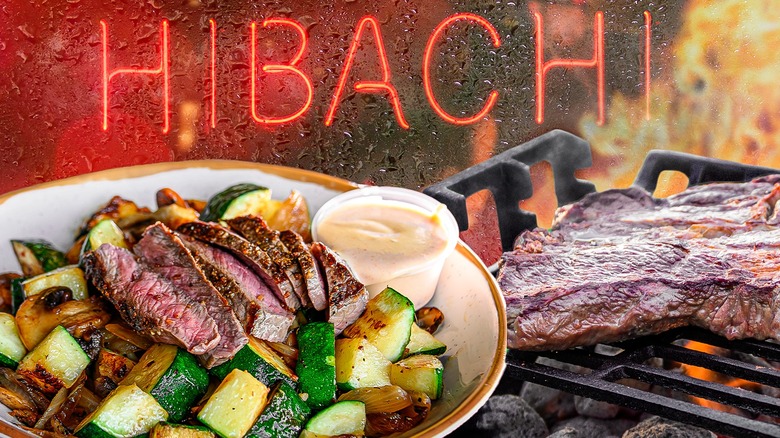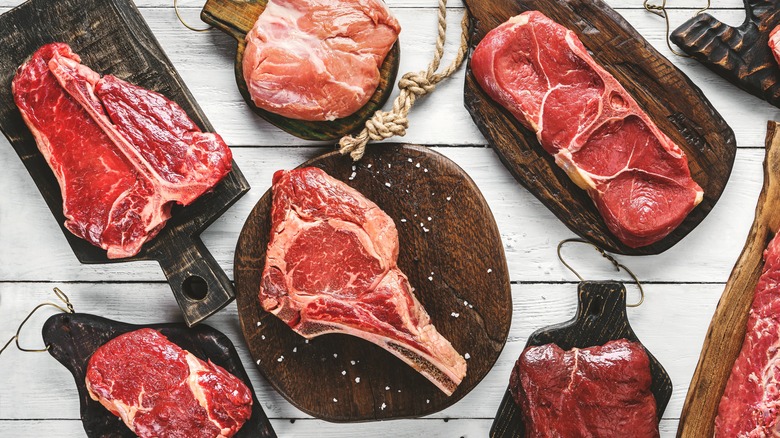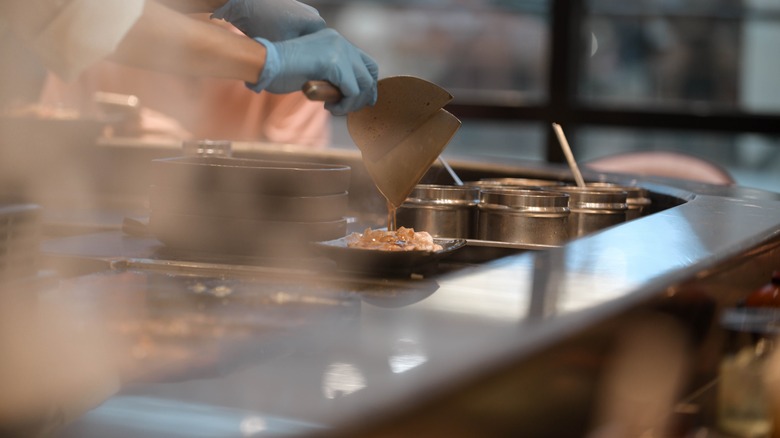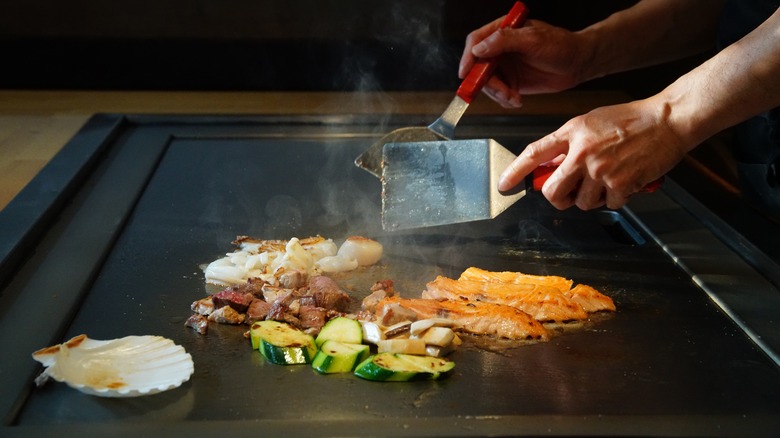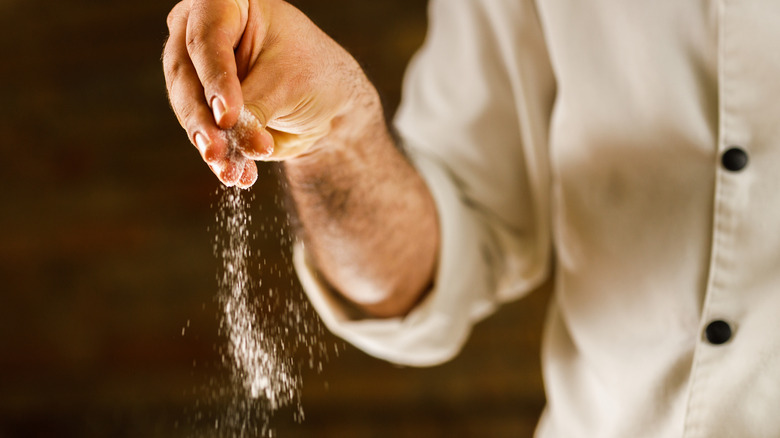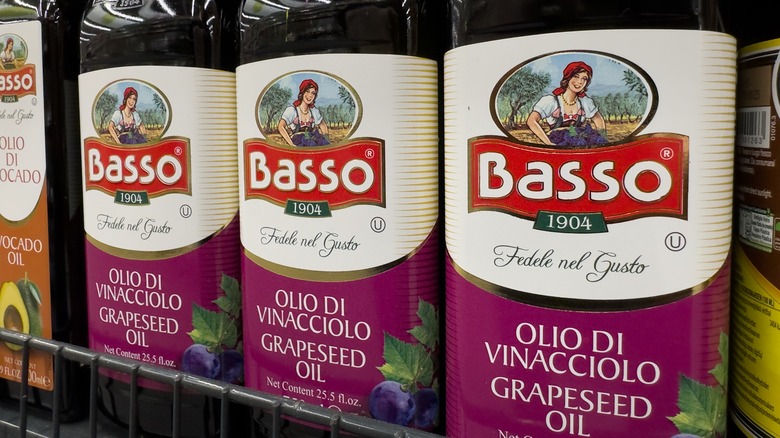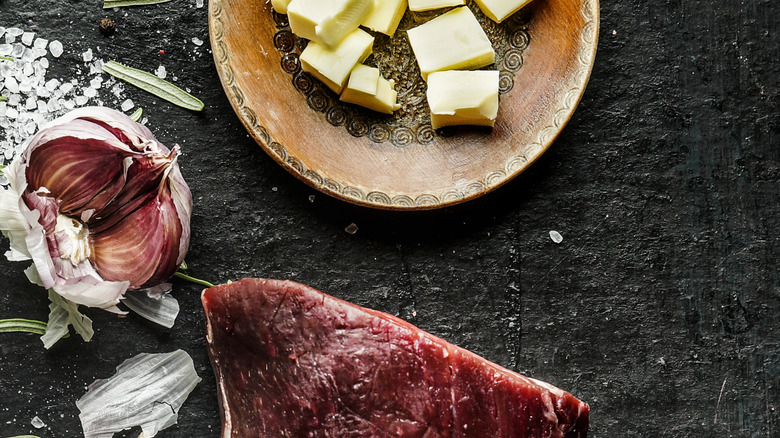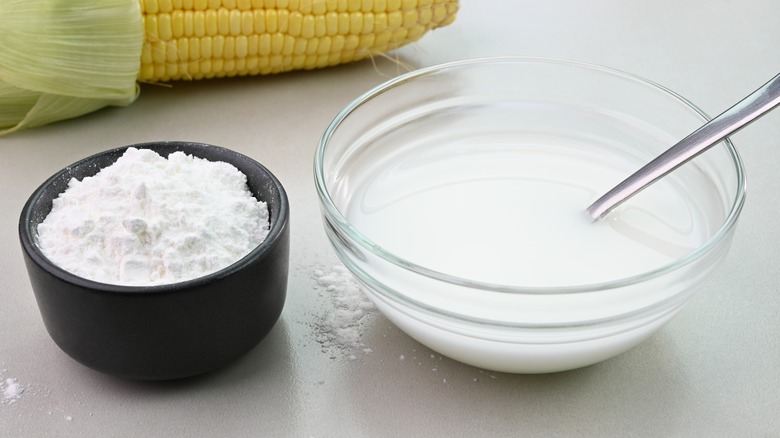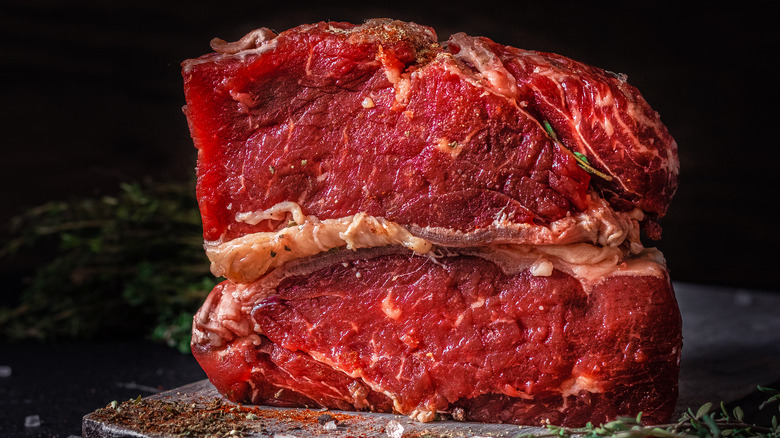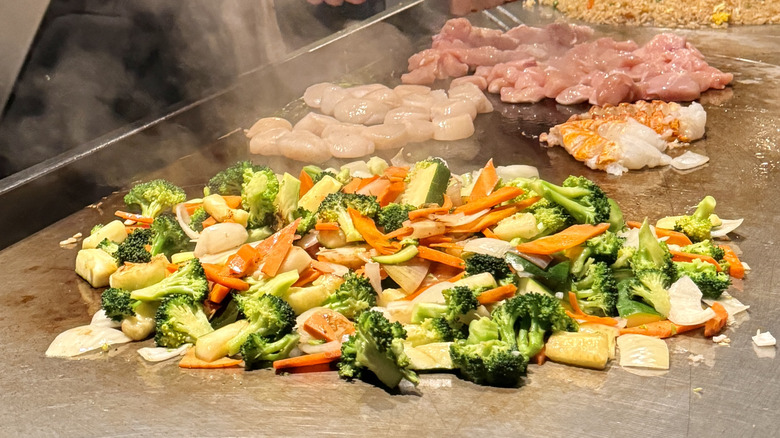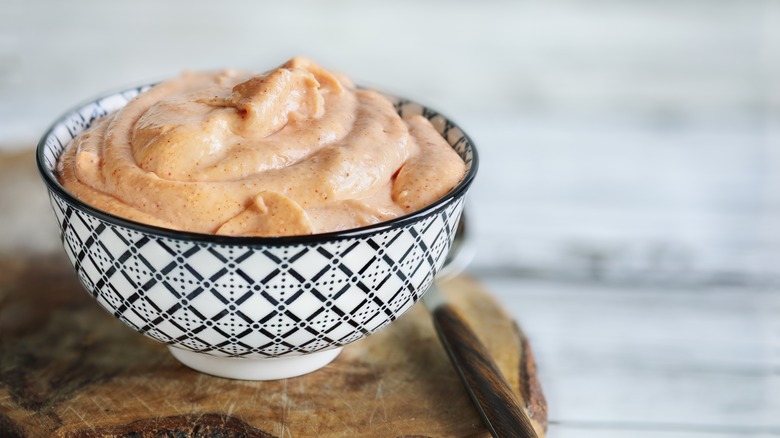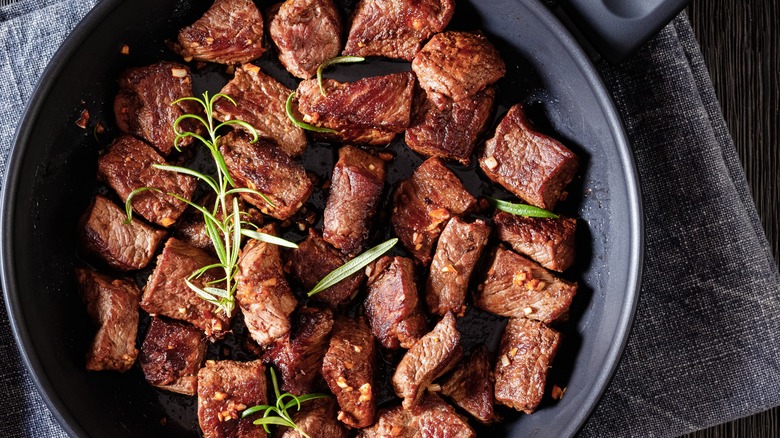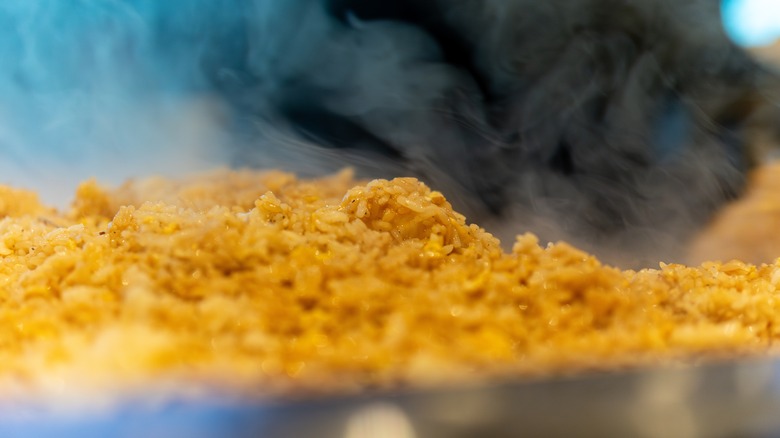12 Pro Tips For Cooking Hibachi-Style Steak At Home
Hibachi-style steak is beloved for its combination of perfectly seared meat, rich buttery flavors, and the cooking experience that often unfolds in front of diners at Japanese steakhouses. Often referred to interchangeably as teppanyaki in the U.S., it's easy to see why it's retained its popularity over the years. It's dinner theater. The sizzling sound, the aroma of garlic and soy sauce wafting through the air, and the sight of a skilled chef expertly flipping steak and vegetables on a hot griddle make hibachi dining special. But what if you could recreate this vibrant experience at home?
While hibachi may seem complex, it's more achievable than you might think, and you don't need to work at Benihana to get good results, either. I spent years cooking in professional kitchens in New Orleans and New York, and while none of them were hibachi restaurants, I'm no stranger to cooking a solid steak of any cut and temp, on any kind of cooking surface. That said, I've studied the blade when it comes to doing my own cooking and eating of hibachi-style steak, but you need not be an expert to shoot your shot.
With a few simple techniques and the right ingredients, you can whip up restaurant-quality hibachi-style steak right in your own kitchen. Whether you're cooking for a small gathering or preparing a special weeknight meal, following these 12 essential tips will help you master the art of hibachi steak. You don't need to have a fancy setup or specialized equipment — just the right know-how and a willingness to experiment. Ready to start learning your hibachi tricks? Let's get into the world of sizzling steaks and savory flavors.
Use the right cut of steak
The foundation of a great hibachi-style steak starts with choosing the right cut. The key is to select tender, well-marbled steaks that can withstand high heat while still retaining their juicy flavor. Cuts like sirloin, ribeye, and filet mignon are top choices. Sirloin offers a perfect balance of tenderness and flavor without being overly fatty, while ribeye brings more bold, buttery richness, thanks to its marbling. Filet mignon, although leaner, is prized for its soft, melt-in-your-mouth texture, which makes it a luxurious option.
When preparing hibachi-style steak, it might be best to stay away from tougher cuts like flank or skirt steak, which may not respond as well to quick, high-heat cooking methods. These cuts tend to need longer marination and slower cooking to break down their fibers. If you want to elevate your home-cooked hibachi experience, invest in a quality cut of steak. Your effort in choosing a well-marbled, tender piece of meat will pay off when you bite into that well-seared, juicy steak. Additionally, keep your steak portions bite-sized for that real hibachi feel, cutting the meat into cubes or strips before cooking. This makes them easier to handle and helps them cook evenly.
Preheat your cooking surface
One of the not-so-secrets of a solid hibachi-style steak lies in achieving a proper sear, which starts with a rippin' hot cooking surface. Before you even think about placing your steak on the skillet or griddle, make sure it's preheated to a high temperature — ideally until it's almost smoking. This step is essential for developing that characteristic crust on the steak, locking in its juices, and giving it that signature hibachi taste.
If you're using a cast-iron skillet or a flat-top griddle, let it heat up for several minutes. Cast iron retains heat exceptionally well, which is crucial for maintaining an even, consistent temperature throughout the cooking process. Once your surface is hot enough, you should hear a satisfying sizzle the moment the steak hits the pan. This initial high heat creates a Maillard reaction, which caramelizes the surface of the meat, leading to that delicious, savory crust.
Remember, if your cooking surface isn't hot enough, the steak will steam rather than sear, resulting in a gray, soggy exterior instead of the golden-brown crust that makes hibachi-style steak so irresistible. Keep the heat cranked up and monitor the temperature to make sure each piece of steak cooks just right.
Use a flat-top griddle
One of the quintessential traits of hibachi-style teppanyaki cooking is the use of a flat-top griddle — a large, smooth surface that allows chefs to cook multiple components simultaneously. Note that this Western style of cooking is different from traditional Japanese hibachi grilling, which uses grates. At home, while a professional-grade hibachi grill may not be available, a flat-top griddle is the next best thing. It provides ample cooking space, allowing you to prepare not just the steak, but also vegetables, fried rice, and other side dishes all at once. This mimics the multitasking magic that happens at your favorite hibachi restaurant.
A flat-top griddle allows for even heat distribution, which is essential for searing the steak properly and avoiding hot spots. When using one, you can replicate that restaurant-style hibachi experience by quickly moving ingredients around the griddle, getting everything to cook at the right pace. Plus, the larger surface allows for more airflow between the steak cubes, which prevents them from steaming and helps them develop that coveted crust.
If you don't have a griddle, a cast-iron skillet can still work wonders. But if you're going for the full hibachi experience, investing in a flat-top griddle will take your home-cooking game to the next level. The bonus? You can use it to cook other hibachi-style dishes, from stir-fried noodles to savory fried rice, all while your steak sizzles away.
Season simply
Hibachi-style steak relies on simplicity when it comes to seasoning, allowing the natural flavors of the beef to shine through. While some might be tempted to experiment with a mix of complex spices, true hibachi-style cooking sticks to the basics. Salt, pepper, and perhaps a touch of garlic powder are all you need. This minimalist approach enhances the steak's savory character without overshadowing it.
Using high-quality steak means you don't need to mask its flavor with heavy-handed spices. A generous sprinkle of salt brings out the meat's natural umami, while freshly cracked black pepper adds just enough bite to balance the richness. A pinch of garlic powder can elevate the flavor without overpowering the dish. If you're feeling adventurous, a light dusting of paprika can add a subtle warmth and smokiness, but it's best to keep additional spices to a minimum.
The key is balance. You want the seasoning to enhance, not overwhelm. Allow the steak's natural fat and the Maillard reaction to do the heavy lifting in terms of flavor. Once you've seasoned your steak, let it sit for a few minutes to allow the salt to penetrate, so each bite is well-seasoned without being overly salty.
Use oil with a high smoke point
When cooking hibachi-style steak, the oil you choose plays a crucial role in achieving that hard sear without burning. Not all oils are created equal, especially when cooking at high heat. To avoid unwanted smoke and burnt flavors, it's essential to use an oil with a high smoke point. Canola oil, peanut oil, and grapeseed oil are excellent options for this type of cooking. These oils can handle the high temperatures required for hibachi cooking while maintaining a neutral flavor that won't interfere with the steak's natural taste.
Avoid using oils like extra virgin olive oil or butter for the initial sear, as they tend to burn at lower temperatures, which can leave a bitter and acrid taste on the steak. Olive oil has a lower smoke point, which makes it more suited for lower-heat cooking or finishing touches. If you love the flavor of butter (which many do), it's best to add it toward the end of the cooking process when the steak is nearly done. This way, you get the rich, creamy flavor without risking burnt oil.
Using the right oil allows your steak a clean, even sear without any harsh, bitter aftertaste. This small adjustment can make a big difference in capturing the essence of hibachi-style steak.
Butter and garlic for finishing
One of the defining elements of hibachi steak is the finishing touch: a generous dollop of butter and minced garlic added toward the end of cooking. This is where the magic happens, transforming a simple piece of seared meat into a restaurant-worthy dish. As the butter melts and the garlic sautes, it infuses the steak with rich, savory flavors that elevate the entire meal.
Good quality butter adds an opulent-tasting, creamy richness to the steak, while the garlic enhances the savory depth, creating that signature hibachi taste. For best results, add the butter and garlic during the final minute or two of cooking. This helps the garlic keep from burning and instead release its aromatic oils into the melting butter, forming a decadent glaze over the steak.
To take it a step further, you can even mix in some chopped parsley or a dash of soy sauce to the butter for an extra layer of flavor. The combination of sizzling garlic and butter creates a mouthwatering aroma that brings the hibachi experience to life in your own kitchen. Just be sure to let the steak rest for a few minutes after removing it from the heat so that the juices can redistribute evenly throughout the meat, ensuring a tender, juicy bite.
Velveting for extra tenderness
For a legit hibachi-style steak, mastering the technique of velveting can make all the difference for tougher cuts of beef, if you have to use them. This technique, often used in Chinese cooking, involves marinating the meat in a mixture of egg white, cornstarch, or baking soda to create an ultra-tender texture with these alkaline ingredients. Although velveting is typically used for stir-fries, it works beautifully for hibachi steak as well.
To velvet your steak, try mixing an egg white with a tablespoon of cornstarch and a splash of soy sauce. Coat your steak pieces in this mixture and let them marinate for about 15-20 minutes before cooking. The cornstarch forms a protective layer around the meat, keeping it moist and tender as it cooks, while the soy sauce adds a subtle umami flavor.
When cooked at high heat, the velveted steak will develop a crisp exterior while staying incredibly juicy and tender inside. This method is particularly useful if you're working with slightly leaner cuts of steak that might otherwise dry out during cooking. After trying velveting, you'll notice how this technique transforms your steak into the melt-in-your-mouth consistency you often find in hibachi restaurants.
Slicing against the grain
After putting in the effort to cook your hibachi-style steak just right, the final step is to slice it properly. Slicing the steak against the grain is essential for maintaining tenderness. If you slice along the grain, you'll end up with long, stringy fibers that make the meat chewier. By cutting against the grain, you shorten those fibers, resulting in a more tender, easy-to-chew bite.
To find the grain, look at the direction the muscle fibers run on the steak — it's often parallel to the long side of the cut. Once you've identified the grain, simply slice perpendicular to it, cutting the steak into bite-sized pieces. This technique is particularly important when serving hibachi-style steak, as you want each piece to be as tender and easy to eat as possible.
If you're cooking the meat whole first, don't forget to let the steak rest for a few minutes before slicing. Resting allows the juices to redistribute throughout the meat, making every bite more flavorful. Skipping this step can lead to a drier steak, as the juices will spill out when you slice it too soon. Slicing against the grain and allowing the meat to rest will let your steak stay tender, juicy, and flavorful.
Don't forget the veggies
A true hibachi experience isn't complete without the grilled vegetables that accompany the steak. Hibachi-style cooking typically features vegetables like onions, zucchini, mushrooms, and carrots, which are cooked on the same hot surface as the steak. These veggies add a nice contrast to the rich, savory steak, offering freshness, texture, and a bit of sweetness to balance the meal.
When cooking your vegetables, keep the seasonings simple — just like with the steak. A sprinkle of salt and pepper, along with a splash of soy sauce toward the end, is all you need to bring out the natural flavors. If you want to add a bit more depth, a drizzle of sesame oil can introduce a hint of nutty flavor to the vegetables. Cook them in batches to avoid overcrowding the pan, which can cause the veggies to steam instead of sear. The goal is to get a nice char while keeping the vegetables crisp and tender.
For an authentic touch, slice the vegetables thinly, allowing them to cook quickly and evenly. Serve them alongside the steak for a complete hibachi-style meal. Whether you're making a weeknight dinner or a special occasion meal, the veggies will add balance and color to your plate, giving you the full hibachi experience at home.
Get the right sauces
To take your hibachi-style steak to the next level, having the right sauces on hand is essential. Whether you prefer something creamy, fresh, or sweet and savory, these sauces will bring out the best in your steak and give you that restaurant-quality touch at home.
Known for its creamy texture and mild sweetness with a hint of spice, yum yum sauce is a crowd favorite in hibachi restaurants. This versatile sauce is made from a blend of mayonnaise, ketchup or tomato paste, garlic, mirin, butter, paprika, rice vinegar, and a dash of cayenne pepper. It's perfect to dip or drizzle over your steak.
Ginger sauce is a refreshing and zesty option that pairs wonderfully with hibachi steak. It's bright and tangy, cutting through the richness of the meat. To make it, blend fresh ginger, rice vinegar, lemon juice, honey, garlic, and onion until smooth. If you're feeling lazy, maybe you can find some ginger sauce at Trader Joe's instead.
For a classic savory-sweet glaze, teriyaki sauce is a must. The combination of soy sauce, brown sugar, honey, ginger, garlic, and water creates a rich, umami-packed sauce that pairs perfectly with the charred, caramelized exterior of hibachi steak.
Get an even sear
One of the hallmarks of hibachi-style steak is the even sear that covers each piece of meat, giving it a golden-brown crust and sealing in the juices. To achieve this, you'll need to make sure your steak cubes or strips are seared evenly on all sides. This is where patience and attention to detail come in — avoid overcrowding your pan or griddle, as this will cause the steak to steam rather than sear.
Cook the steak in small batches, making sure that each piece has plenty of space around it. If necessary, work in multiple rounds to make sure every piece gets the proper sear. Use a pair of tongs to rotate the steak cubes, checking that each side gets a nice, even crust. The key is to leave the steak undisturbed for a minute or two on each side to allow the surface to caramelize. Constant flipping or stirring will prevent the steak from developing that desirable crust.
Getting an even sear is crucial for both flavor and texture. It creates a satisfying contrast between the crispy exterior and the tender, juicy interior, making every bite of your hibachi steak a true delight.
Garlic butter fried rice
No hibachi meal is complete without the signature side of garlic butter fried rice, a staple that complements the richness of the steak. The key to great fried rice is using leftover or day-old rice, which is drier and less likely to clump together in the pan. Start by melting butter in your griddle or skillet, then saute minced garlic until fragrant. Add the rice, stir to coat it with the buttery garlic mixture, and season with soy sauce for that savory, umami flavor.
To achieve that real hibachi-style fried rice, keep the rice moving constantly in the pan to allow even heating and prevent it from sticking. You can also toss in some chopped green onions or peas for added color and texture. The goal is to infuse the rice with the flavors of butter and garlic while keeping it light and fluffy.
Serve the fried rice alongside your steak for the ultimate hibachi-style experience at home. The combination of juicy steak, rich garlic butter rice, and savory vegetables creates a meal that feels indulgent but is easy enough to prepare in your own kitchen.
